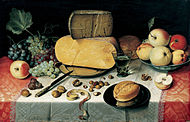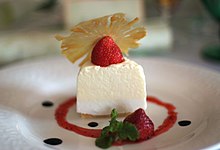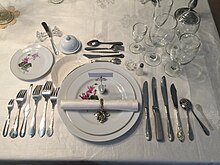Full-course dinner
This article needs additional citations for verification. (July 2015) |
| Part of a series on |
| Meals |
|---|
 |
| Meals |
| Components and courses |
| Related concepts |
 A European/American 13 course table setting | |
| Type | Meal |
|---|---|
| Course | At least three |
A full-course dinner is a meal with multiple courses, almost invariably enjoyed in the evening. Most Western-world multicourse meals follow a standard sequence, influenced by traditional French haute cuisine.[citation needed] It commonly begins with an appetizer, followed by the main course, the salad course, and eventually the dessert, but the exact sequence varies widely. Full-course dinners are generally very formal as well as very expensive, and can have as few as three courses or exceed a dozen courses.[1] Styles of service include service à la russe and service à la française.
The idea of traditional, ritualized, multi-course meals dates back to at least Ancient Rome, where the meal began with the gustatio, a variety of herbs and hors d'oeuvres, then continued through three main courses, and finished with a dessert.[2]
Basics
[edit]A multicourse meal or full-course dinner is a meal with multiple courses, typically served in the evening or late afternoon. Each course is planned with a particular size and genre that befits its place in the sequence, with broad variations based on locale and custom. Miss Manners offers the following sequence for a 14-course meal:[3]
- Oysters or clams on the half shell. Fruit or caviar may be served instead.
- Soup, giving each guest a choice of clear or thick.
- Radishes, celery, olives, and salted almonds.
- Fish, served with fancifully shaped potatoes and cucumber with oil and vinegar.
- Sweetbreads or mushrooms.
- Artichokes, asparagus, or spinach in pastry.
- A roast or joint with a green vegetable.
- Frozen Roman punch
- Game, such as wild duck or small birds, served with salad.
- Heavy pudding or another creamed sweet.
- A frozen sweet, possibly with small crisp cakes.
- Cheeses, with biscuits and butter, or a hot savory of cheese.
- Fresh, crystallized, and stuffed dried fruits, served with bonbons.
- Coffee, liqueurs, and sparkling waters.
Meals like this are generally very formal as well as very expensive. In formal dining, a full-course dinner can consist of five or more courses, and (in rare cases) as many as 21 courses.[citation needed] In these more formalized dining events, the courses are carefully planned to complement each other gastronomically. The courses are smaller and paced through the evening, lasting three to five hours. They follow conventions of menu planning that have been established over many years. Each course of a highly formal dinner (excluding some light courses such as sorbets) is usually paired with a different wine, beer, liqueur, or other spirit.
Service à la russe
[edit]In one modern version of service à la russe, courses are brought to the table in sequence. Only empty plates are set in front of each guest and guests individually fill their plates with selections from a variety of dishes. In another, common in restaurants, a filled plate is placed in front of a guest, pre-portioned away from the table. Often the meat is pre-portioned, but diners serve themselves with vegetables and side-dishes. In an American formal dining course, typically each course is served sequentially. Guests are served plates already filled with food in individual portions. Often, guests have an opportunity to choose between vegetarian or meat main course. Traditionally, there is no opportunity to request something different or to ask for more than a single serving.[citation needed]

Service à la française
[edit]In service à la française, food is served "family-style", with all courses on the table at the same time. Guests serve themselves so that all dishes are not served at their optimum temperatures. Alternatively, buffet style is a variation of the French service where all food is available at the correct temperature in a serving space other than the dining table. Guests go to the buffet to be served or sometimes serve themselves and then carry their plates back to the table.
Table setting
[edit]
Table settings can be elaborate. More formal settings sometimes include all silverware and glassware that will be needed for the entire meal, and lay out the silverware so that the outermost tools are used for the dishes appearing earliest on the menu. In this scheme, when diners are served the first course, they can depend on finding the correct implement at the outermost edge of the arrangement.
A 13 course place setting includes multiple utensils, receptacles, and vessels. The plate is flanked by a caviar spoon, cocktail fork, escargot fork, bouillon spoon, fish fork and fish knife, lobster pick, and bone marrow spoon, as well as an entrée knife and fork, relevé knife and fork, and salad knife and fork. Above the place setting are laid a bread knife (on a knife rest), a plate with a personal butter dish, a fish bone dish, a sorbet spoon, a cheese knife, a nut pick, and also a dessert fork and dessert spoon. To the right of the plate a salt cellar and spoon with pepper is supplied. Glassware includes a water goblet, champagne flute, white wine, red wine, dessert/sherry, and port glasses.
An alternative scheme arranges the place setting so that only the implements needed for the first one or two courses appear in the table setting. As the dinner progresses and new courses arrive, used implements are removed with the dishes, and new utensils are placed at the plates. This scheme is commonly used when dinners are offered à la carte, so that the most appropriate implement is selected for a given course. For example, some diners may order clear, thin soups and others may order thick, creamy soups. As each of these soups has its own unique spoon,[4] it would be considered improper and impractical to lay out a spoon that may not be needed.
See also
[edit]References
[edit]- ^ "This is why fine dining food is so expensive - Trademagazin". trademagazin.hu. 2024-08-30. Retrieved 2024-11-03.
- ^ Strong, Roy C. (2002). Feast : a history of grand eating. Internet Archive. London : Jonathan Cape. pp. 33–34. ISBN 978-0-224-06138-4.
- ^ Martin, Judith (1982). Miss Manners' guide to excruciatingly correct behavior (1982 reprint ed.). New York, NY: Warner Books. p. 492. ISBN 978-0-446-37763-8.
- ^ Lininger, Mike. "Spoons". Etiquette Scholar.
